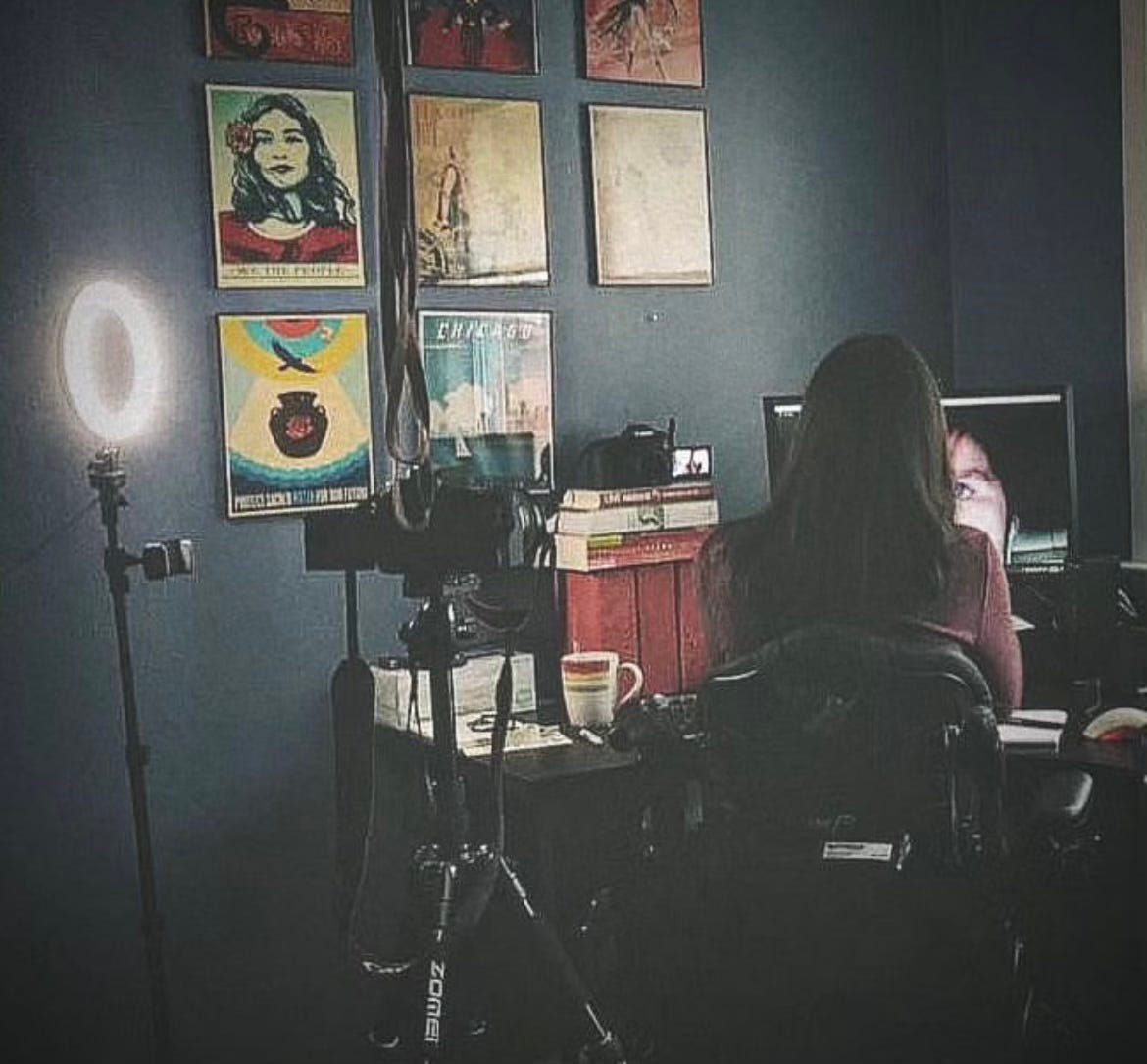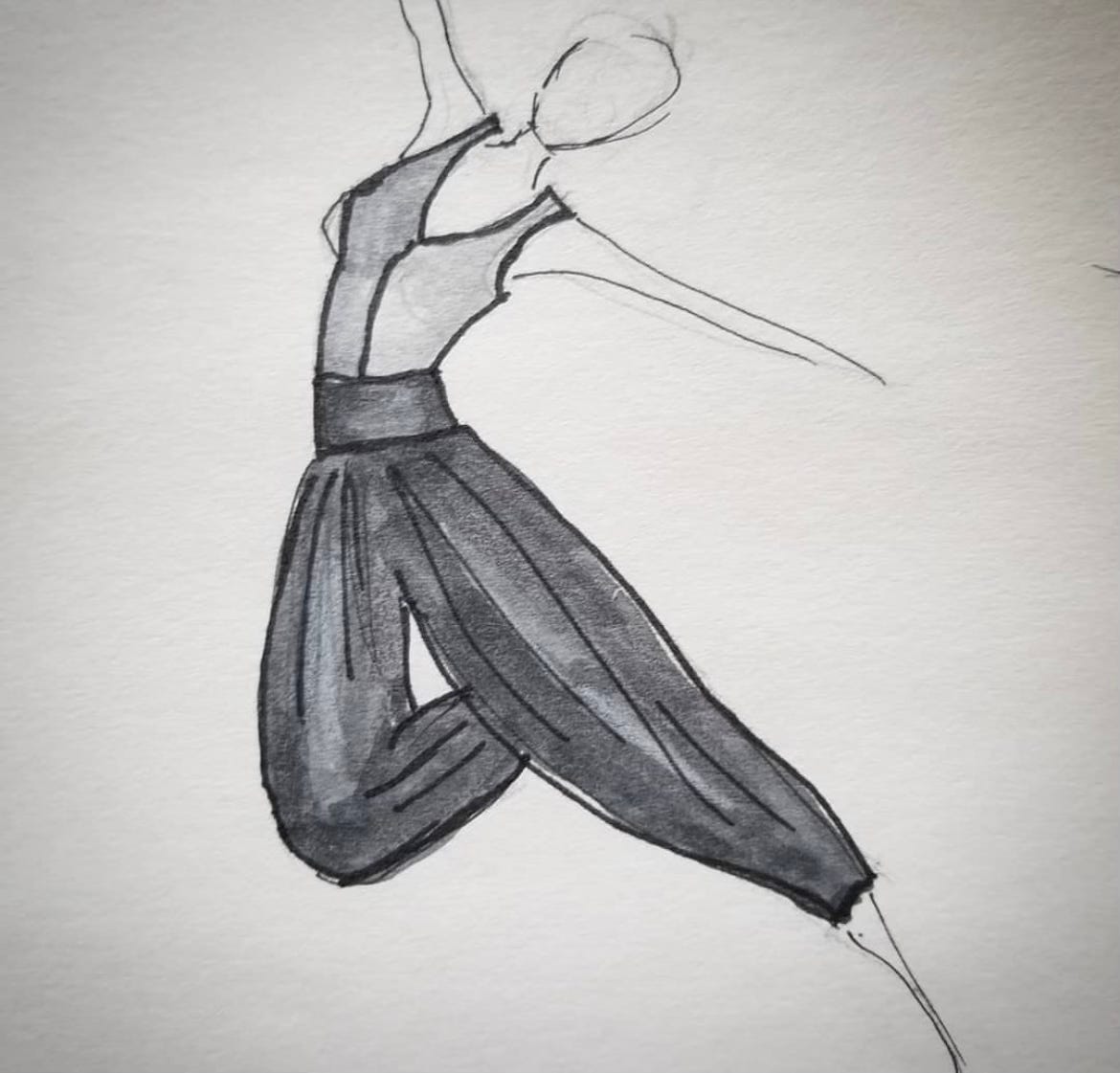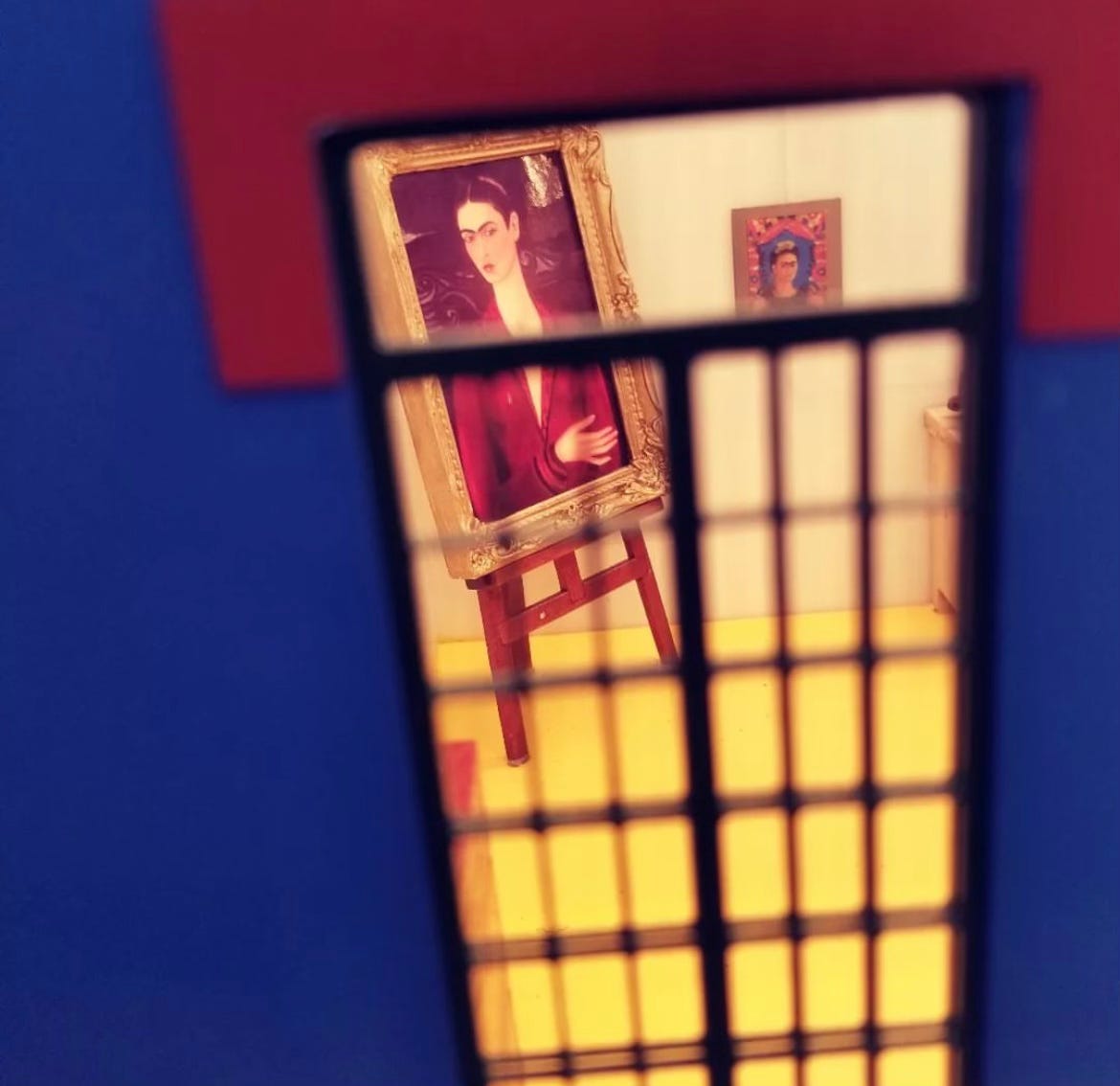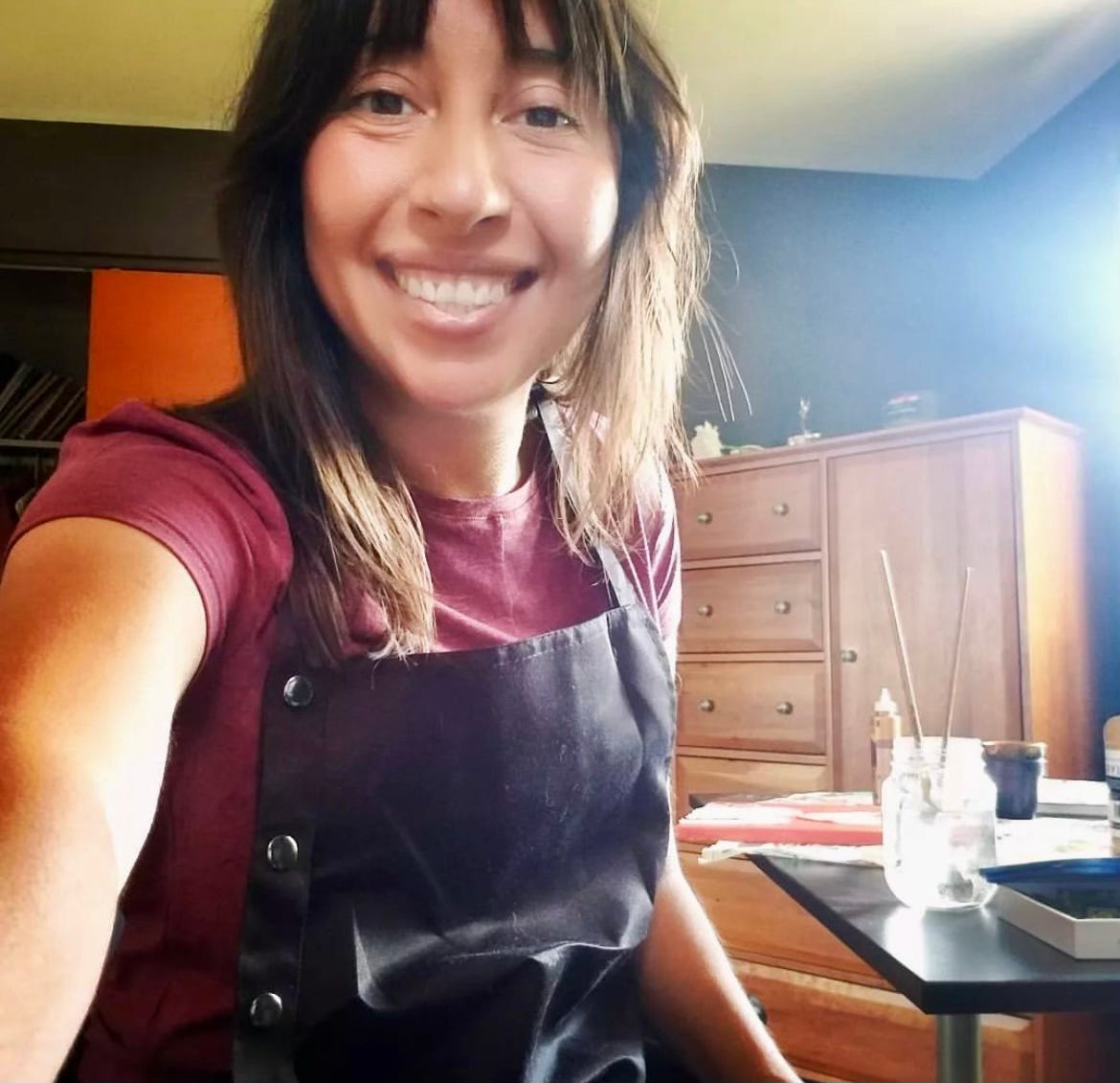Holding the Door Open: Reveca Torres on the Measurable Metrics of Connection, Humanness and Art
Part 1 | Special Series: Hold the Door Open—Making the Invisible Disability Community Visible | By Kimberly Soenen September 2, 2024
Reveca Torres is the Founder and Executive Director of Backbones, the Peer Connect organization for persons with disabilities.
In 1994, when she was 13 years old, Torres was in a car accident that altered the trajectory of her life. Now, at the age of 43, she works across interdisciplinary circles nationwide on Health Philosophy Transformation.
I caught up with her recently in Chicago to discuss Disability Rights Education, modern design, the Americans with Disabilities Act, and what, if anything, on the heels of the Democratic National Convention, she is hopeful about in the context of progressive health policy, practices and progress.
SOENEN: You just celebrated a very important anniversary in Chicago in early August. What was that special event and what did it mean to you and the Disability Community?
TORRES: We celebrated the 15th anniversary of Backbones. It was a really special night because it brought back a lot of people that have been involved in the organization over the last 15 years. I saw some people who were a part of it right from the very beginning, like the guy who created the very first website we did, and has done our photography since. So many people have been with us since the beginning. New people who just graduated from our Backbones Leaders Program also came to celebrate and, like so many, they continue to be involved.
It was really special to see all of these people come into the room. The energy was just so loving and it felt like community. I felt loved and I felt really proud of all the things that I have done over the past 15 years. All of these people have contributed to being a part of this organization and have contributed to building it. I hope that they all felt that same energy and enthusiasm that I did when they left the event because I definitely felt it.
SOENEN: What does Backbones do and why did you start it?
TORRES: When I started out, I envisioned peer support, specifically one-on-one peer support. Being able to relate to somebody that has gone through an accident, injury or life-changing disability is important to community and self confidence.
For me, after my accident, although I had a large, loving family and very good friends supporting me after my injury, I didn't meet a lot of people. Or, if I did, I didn't form friendships with people that were wheelchair users or had a similar disability. I sort of stayed away from the Disability Community because I kind of felt like “I am not going to be part of that community. I'm going to be normal; I'm going to be fine and everything's going to be okay,” which, I wasn't.
I am definitely part of the Disability Community.
When I finally accepted that, my life changed. When I started meeting people like myself, I understood that I could do so many other things and that I could sort of get rid of that baggage, I guess, of trying really hard not to be disabled. So, that was the initial motivation for Backbones. I wanted to be there for people to find that connection and to make sure they did not feel isolated after their injury.
And, now, here we are 15 years later.
Over the years, connections have definitely been at the core of the mission and it has become really, really clear over the years when I've evolved to try different things and always come back to that main value of those personal connections and how important they are.
Whether you're meeting someone new, looking for a job, trying to grow professionally…whatever it may be, it is so important to make those connections. That's been the underlying theme of everything we do at Backbones. We bring people together so they can meet each other so they can leave that space feeling less alone.
SOENEN: How do you measure the success of Backbones?
TORRES: Often, we get people asked, “So, what exactly do you do? You throw parties and you make connections,…what does that mean?” I feel like sometimes people don't put a lot of value on that because they think, okay, we want impact, we want metrics, outcomes, and concrete immediately quantitative results. They want to see what are “numbers are,” how many people we have impacted this year, and so on. Have your programs done X, Y, and Z? they ask.
SOENEN: What is the impact for those who engage with Backbones?
TORRES: People participate in a Backbones event or they'll be part of one of our programs and they gain this confidence in themselves that you can see. You can see it right away. It's like a little twinkle when they leave an event or they're finish a program, and I can tell they're going to do more things with confidence and whatever it is that they're going to do makes them hopeful—maybe they're going to write a book, maybe they're going to go into advocacy policy, make a film, get a new job, start a family, whatever. So you see, the impact of our work is not always immediately apparent until down the line where you see these people are doing these things that they've always wanted to do or they were afraid of doing and were being held back. Through our programs people gain that confidence. We open a door for them.
SOENEN: What frustrates you most about the perception of persons with disabilities?
TORRES: There are a lot of things that frustrate me, but I think one of the things that frustrates me most is this lack of expectation that we can hold space and power in society. The assumption that a disability equals less than... our disability means less able or incapable. That is a very narrow-minded way of seeing a whole population of people that are contributing greatly to society, who are thought leaders, who are changing policy, who are creating great art, who are making music... yeah, the Disability Community is a culture to be celebrated, not a sad population that needs to be pitied. We need to remove these barriers so that we can continue to thrive.
SOENEN: What frustrates you the most about the treatment of disabled persons?
TORRES: Underestimating our potential, disregarding us and not providing avenues for leadership and empowerment. Also not considering disabled people in every aspect of life, even though we do make up the biggest minority or identity that everyone intersects with in society.
SOENEN: How do you define health in 2024?
TORRES: The the way that we manage our bodies and mind and our wellbeing and having autonomy over that.
SOENEN: Does the ease with which disabled people can communicate with one another online minimize isolation, or do social media and technology increase the feeling of isolation?
TORRES: Yes and no. Backbones from the very beginning has always been very remote and virtual, even though we do host a lot of events in person. Most of us are used to working from home. Then, the Covid pandemic happened and I'm like, okay, well, we're not going to be able to do our in-person events anymore. But prior to that, we had already started our Peer Connect program, which is a monthly program where we meet over Zoom every month, and we talk about a different topic.
Peer Connect was developed because there were people that were not able to go to our live events in person, because they were living in rural areas, or they had a pressure sore and couldn't get out of bed, or they didn't have transportation…whatever the case may be, there's so many people that could not make it to our events, and they would be like, when are you going to come to my town? Or, how can I participate?
That's how we started the Peer Connect program as a monthly online meetup. People were looking for connection, and were trying to find ways of not feeling isolated more than usual. These virtual meetups became a way for them to connect with people and not feel alone and talk about what they were feeling…what they were going through.
We have increased access to employment, recreation, fitness, sex education, creative hubs and connecting with friends all over the the United States. It's a really good thing.
SOENEN: You've elevated a lot of conversations around day-to-day living centered on disability and Spinal Cord Injury (SCI.) You've written and hosted events about sex and dating; what it's like to be a parent with SCI; having your wheelchair damaged when you're traveling on the airlines; and the benefits of sauna, dance, yoga and even the pros and cons of exoskeleton suits. What are the topics do you want to address now?
TORRES: Where do I start? Because there's just so much to do. The United States is just really far behind. The society seems to think like, oh, but there's the ADA (Americans with Disabilities Act enacted in 1990) and when we experience barriers and limitations we are told “you should call the ADA and report that.”
SOENEN: How has the ADA served you?
TORRES: I mean, it was a really big step for the Disability Community. I'm not going to disregard that. But it feels like we're at a standstill sometimes. Just because that law is there, that doesn't mean that things are truly changing. It doesn't mean that society has changed their views of people with disabilities. It doesn't mean that people don't get discriminated against or are limited out in the world. We still aren't able to get jobs. We are still viewed frequently as an after thought or inconvenience.
SOENEN: How do you/we define true accessibility?
TORRES: Acccessibility does not just mean for the Disability Community or one particular population. If it is smart and safer for us, generally it is smart and safer for everyone. It is something that can universally helpful to everyone, and it's frustrating to see when that doesn't happen.
SOENEN: What are the barriers to modernization and making cities and rural areas more like Portland and less like Manhattan, or more like Munich and less like Chicago? What are the biggest barriers to accessible design?
TORRES: I think it's attitudinal barriers. It's not necessarily the act of doing it. It is the act of wanting to do it because it's the right thing and because it's going to benefit people and give access to people and include people in our society. That's what it is. There needs to be a lot more education and encouraging people to truly understand why it's important.
SOENEN: You're out there in the interdisciplinary mix. What are you hearing from people about accessibility? How do you get into the right rooms and cross over to educate people?
TORRES: Oftentimes, having these conversations both with people directly one-on-one and with an audience (or on a podcast or in a blog.) If you and your family are not touched or affected by Disability, it's out of sight, we are out of sight. But I'm very hopeful that in general, people are receptive to consideration and respect.
SOENEN: What is the best communication mechanism for transforming thinking, practices and policy?
TORRES: For me, creating art and media is the way to get to people to understand and relate because for me, personally, policy and legislation are boring. I will read bills and have no idea what they say and am not always convinced it will change things for the better.
By using art and media and by getting people to understand the day-to-day reality for disabled people, that is something they can understand…something that they can connect to. Again, going back to that connection piece, maybe they can connect to art because they like a color and it draws them in, but then they read the message behind it and understand that maybe it's about caregiving and the caregiving crisis or something like that. Or maybe there's a photograph of something that draws you in. Then you learn about adaptive sports. So, art makes our reality and lived experience more relatable. They can grasp it and through art and connection we can bring people into this world.
SOENEN: Is “Disability Community” the correct term to use in 2024? “Community” is not a word I use lightly or often because it strips away the diversity and complexity within a person and population.
TORRES: I think you have a good point. I think the term “Disability Community” is used, and I use it. A lot of people use it, and it's a way to name this group, to identify this group. But I want to go a little deeper because there's a lot of people that shy away from using the word “disability” or “disabled,” and they go into using terms, “special needs” or “differently abled” and so on.
We are disabled, we do identify as disabled, and it's okay to use it rather than coming up with these other terms that are not really representative of it. The reason why people don't want to use it is because they think it's a negative thing. When you take the negativity out of it, that's when you start building a vibrant, engaging, healthy community that celebrates itself. That's when you start building pride. You start losing shame and feeling like we have a space in the world and in society rather than being considered outsiders.
SOENEN: In the day in a life of a person with Spinal Cord Injury (SCI), how much time goes into daily survival, self care and health maintenance?
TORRES: I can only speak for myself, but other people may have similar experiences and similar routines, but for me, it takes me anywhere from two to three hours in the morning to get ready for my day.
I get up at 7:00am, do stretches, use the bathroom, shower, you know, get ready, get into my chair, eat, and then I'm ready to work. All of this is dependent on having a caregiver that comes in and helps me in the morning. If the caregiver is late or does not live with you, there are delays.
It's essential, too, for me to do those stretches in the morning otherwise, my body is in pain throughout the day. I try and do some exercising in the middle of the day, stretching, because I do spend a lot of time in front of the computer, and sitting all day. In the evening I have a bike where it moves my legs for me to just kind of get some circulation, some movement. It relaxes my hips. It's a time where I'll listen to an audiobook, or I'll listen to nothing. It's just kind of me disconnecting. Then I go into my little sauna thing, which is an infrared light setup that has heat, and that heat helps me relax before I can go to bed. I have chronic pain, and it helps me to function.
SOENEN: Recently, there has been a lot of pressure on lawmakers to pressure airlines to handle wheelchairs with care after many persons with SCI have had their wheelchairs damaged while traveling. Can you speak about the importance of mobility?
TORRES: The airlines. Yes. Mobility is important. I use a wheelchair to get around and, you know, even in people's homes, there are not a lot of homes that are actually accessible, and people have trouble finding housing, finding an accessible house, an affordable, accessible house. Or, when they do find a home that could be adapted, you have to spend a lot of money to adapt it to your needs or to your access needs. It is very expensive and something a lot of people can't do, or, if they can afford an apartment, you're not allowed to make those changes or it comes out of your pocket to do it, and then you have to switch it back to its original state after you leave.
Going out into the bigger world, where there are often no ramps, it is tough. Wheelchairs are our freedom to get around, to go to all these places. We have to pay to modify our cars; leave early to use public transportation because elevators are often broken; or use Uber which is not always accessible. We cannot plan impromptu or move through the world quickly. Delays and hassles are expected on top of the bias and ignorance sometimes.
SOENEN: How can society improve design and transportation?
TORRES: We need to bring in people with a variety of different disabilities to guide decisions and planning in urban and rural areas because all of these things require communication with society, with constituents. Who's on the road, who's on a bike, who is living in these areas, how do people need to live? It's not just language communication. I think it's communication among these, like, entities and ways of interacting in the world, if that makes sense.
SOENEN: The activist and lawyer Ady Barkan recently died and so, too, did Judy Heumann who was widely regarded as the leader of the Disability Rights movement. What did these two people mean to you?
TORRES: These activists in their legislative efforts were grand and we need people like them to make change and to rally other people to get motivated to make change or support that change. There are people that I admire and wish we had more of. We need people that can help us get access to healthcare, eliminate some of those barriers, and then create quality healthcare for people with disabilities, because oftentimes, people with disabilities are disregarded in, like, with our symptoms they don't believe them, or they don't even have a table or equipment to even give us proper exams.
SOENEN: What would you like to see changed in Accessibility Law?
TORRES: I wish we did not have to file a case on discrimination every time we experience it and that the burden was not on the people experiencing that discrimination to file it and get that to go through. I wish the burden was on the business or the institution.
SOENEN: What does art mean to you?
TORRES: Art is part of my life. I don't think I could live without it. It helps me navigate my world. It helps me figure out what's in my brain, process, emotions, and also communicate externally. It also means a profession and a career for me. Yeah.
SOENEN: After March of 2020, have you seen more engagement with Backbones? There were just so many issues that impacted the Disability Community during the height of the Covid pandemic. The invisible harm was horrifying for those of us who chose to look. Do you think that persons with disabilities got louder after Covid about their needs, and what legislation that needs to be changed? What are you personally feeling now?
TORRES: I think it goes up and down and definitely people got louder and people got frustrated and gathered together to talk about what they were feeling. There was a lot of mutual aid happening among our community. I think that happened because people are aware of what it's like to be isolated. We're aware of not having things. Society feels “I have a right to this and I'm entitled to this.” And so, when all that got taken away at the beginning of the pandemic, people were freaking out and the Disability Community kind of rallied together and was like, we can do this, we are accustomed to isolation and going without, and we can help.
SOENEN: You were acclimated to isolation already to some degree, right?
TORRES: Yes. In a sense it was like, okay, the world is sort of realizing what this is, the world is realizing what this is like, and that got people wanting to speak up to fight against some things.
SOENEN: I notice at the majority of “health” and “healthcare” conferences—from Google to STAT News to the American Medical Association and others— there are rarely disabled attendees or presenters at the conference. It is astonishing to witness in 2024.
TORRES: I think slowly these conversations will creep into the circles of people in power, and I'm hopeful that that happens. I'm also starting to see, again, my world is in art and media, a lot of people are asking questions like: Do you identify as disabled? Or,: How can we make this program more accessible to you? Whereas, you didn't see that before the pandemic. You didn't see that when you went to someone's website and you use to really have to search. If someone mentioned “disability” on their website or “we will provide accommodation” you really had to dig. These people are now thinking about us. So, it's nice to start seeing it on websites, on brochures, on social media, even influencers using the captioning, probably because, not for disability reasons, but they are being more accessible because they're using these features that are becoming more mainstream.
SOENEN: The Democratic National Convention just wrapped here in Chicago. Everything changes and everything stays the same. Right? What would you like to see enacted for the Disability Community in the context of health, healthcare, Health Policy and Health Law?
TORRES: I am hopeful that I'm starting to see some new advocates come out of some younger people that are starting to be advocates in different ways. They're using social media in such a cool way and a platform to share ideas, whether it is political or if it's every day showing everyday lives or showing their art or music. Their disability is becoming more visible and I am seeing younger kids understanding that disability is part of life and being more inclusive. So that makes me hopeful that those attitudinal barriers will, and those stereotypes will, hopefully be less over the next coming years. That inclusion isn't like this chore.
SOENEN: It's a long haul running an organization for 15 years. It requires a lot of personal, spiritual and sweat equity. As you look to the future, what are you feeling?
TORRES: We still have a very, very long way to go in terms of getting people in power to talk about these disability and inclusivity issues and to remember to include them when they give a speech or when they are talking policy. How is this going to impact our community? Are we an after thought, another society, or are we all part of society?
SOENEN: Any heroes in your mind?
TORRES: Judy Heumann, of course, who was a big advocate for people with disabilities. Many people living in Chicago are currently advocating for different things. Mike Irvin writes the blog called “Smart Ass Cripple,” and Rahnee Patrick who is a disability policy expert trying to move the dial on intelligent design and policies. Different artists are always organizing and everyday people are doing good work and making change in our communities. Those are my every day heroes.
SOENEN: Are you hopeful?
TORRES: Sometimes. I am seeing a lot of change surrounding Disability Rights and Disability Justice, so I'm hopeful that the younger generation of disability advocates steps up and continues this work.
SOENEN: I am looking forward to the next 15 years of Backbones and we are all looking forward to the release of your forthcoming film in 2025. The Disability Community in the United States is lucky to have you at the helm of Backbones.
TORRES: Thank you. This was fun.
ADDITIONAL RESOURCES
Visit @revecart and RevecaTorres.com and Backbones for more information, artist credits, news and events.













